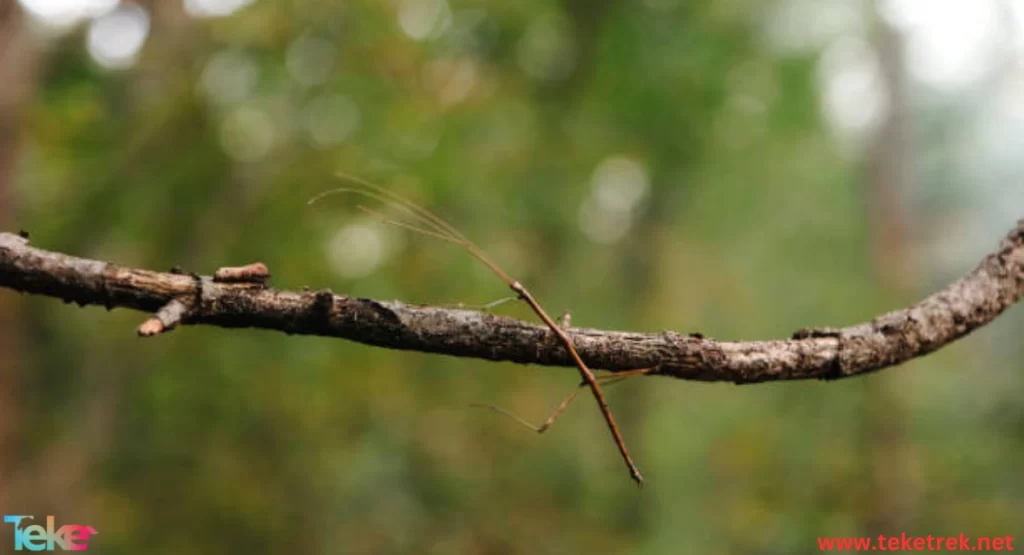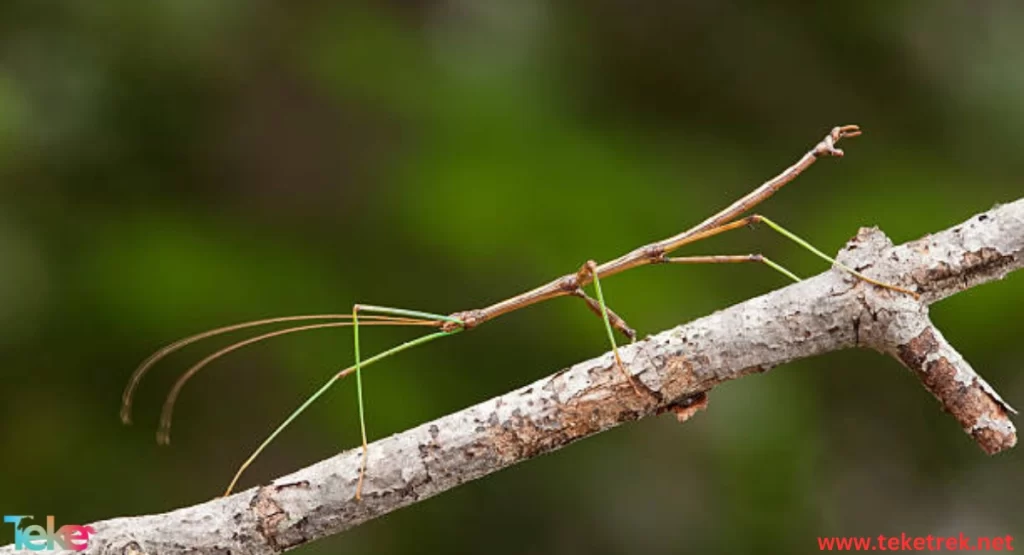It belongs to the phylum of arthropods.
Stick insects looks very similar to a stick, and have a great camouflage ability, blending in with their surroundings.
Let’s learn more about it from teketrek.

Facts about the Stick insects:
resembling small branches both visually and behaviorally, as well as plant stems.
Stick insects belong to the order Phasmatodea.
These insects are known for their peculiar appearance resembling branches, which serves as a defense mechanism against predators.
There are around 3,000 species of stick insects, most of which are found in tropical regions.
The highest diversity of stick insects is in Southeast Asia, South America, and Australia.
Their exceptional camouflage ability, which helps protect them from various predators.
Stick insects can feign death to deter predators and can regenerate lost limbs to escape from predators easily.
A stick insect can regenerate its limbs and, if captured by a predator, can easily escape. She gives up her leg because there is a special muscle to break it in a weak joint.
Stick insects can reproduce together without the need for the presence of males, and it must be noted that the stick insect has the ability to reproduce completely without males. When mating with males, the offspring are males, but they alone produce females.
insects not only look like sticks but also behave like them, swaying in the wind like tree branches to avoid predation.
To avoid predation, stick insects are nocturnal and spend most of their days motionless on plants or under them, only coming out at night to feed.
Stick insect eggs are dropped on the ground and left to fate.
When a predator approaches, stick insects may flash their wings to startle the predator before hiding them again, leaving the predator confused and unable to locate its target.
In the wild, stick insects can live up to 3 years on average.
The Stick insect specification
The shape: The shape of stick insects varies from a small brown ant-like form in the first stage to a large green or yellow adult with wings.
Size: Stick insects can range in size from 0.46 to 12.9 inches.
Length: With an average length of 12 inches.
The body: The body of a stick insect is divided into three parts: the head, thorax, and abdomen.
The head: The head of a stick insect has a pair of sensory antennae
Shell: and the body is covered in a hard outer shell made of chitin.
Wings, legs: The thorax of a stick insect has two pairs of wings, while the legs are long and thin.
Where did the stick insect live?
It is found in temperate, tropical and subtropical regions of various continents except Antarctica. Stick insects are found in Southeast Asia, South America, as well as the large island of Borneo in the Pacific Ocean.
Stick insects can be found in New South Wales and South Queensland, as well as in the north in Cairns.
Reproduction stages of stick insects:
Reproduction in stick insects is one of the most complex things and distinguishes them from other animals as mating and courtship continue for a long period.
Stick insects not only rely on visual signals for mating but also release chemicals that attract other insects.
In the absence of males, stick insects produce female offspring from unfertilized eggs, known as parthenogenesis.
In some species, ants carry stick insect eggs to their nests, protect them, and keep them safe. After hatching, the young leave the ant nests, forming a mutually beneficial relationship with the ants.
what are the harms of stick insects?
Touching this insect may cause allergies, eye redness, and continued tearing.
When a stick insect bites a human, it can cause respiratory system allergies.
Sometimes, the bite of this insect can transmit viruses in the blood and liver, posing a risk to humans.
The bite of this insect can lead to human death.

FAQs about the Stick insect
Can a stick insect fly?
Some species of stick insects possess wings and are capable of flight.
How long do stick insects live?
It lives for about 18 months.
What eats a stick insect?
Walking sticks are a favored meal for many animals, but their most formidable predators are likely bats.
Is a stick insect a good pet?
Keeping stick insects as pets can be an enjoyable and rewarding experience.
Do stick insects need light?
Stick insects love one to two hours of afternoon sunlight, but don’t keep them in direct sun.
Are stick-bugs harmful?
It is not a light on humans.
What do stick insects eat?
Stick insects feed on plants and green branches like other insects, it eats blackberry leaves.
What are Stick insect species?
Some important species of stick insects include:
– Pink-winged stick insect.
– Giant Australian stick insect.
– Woodland nymph stick insect.
– Thorn-legged stick insect.
In conclusion, we have discussed the importance and risks of the stick insect, and caution should be exercised when dealing with it. They are like withered branches that are difficult to detect because they are camouflaged in a tangle of foliage. We hope we have provided you with valuable information about this fascinating type of insect.
References





